1. One man who drinks alcohol and smokes cigarettes lives to age 90 without getting liver or lung cancer; another man who smokes and drinks the same amount gets cancer at age 60. One woman's breast cancer responds to chemotherapy, and her tumor shrinks; another woman's breast cancer shows no change after the same treatment. How can these differences be explained?
2
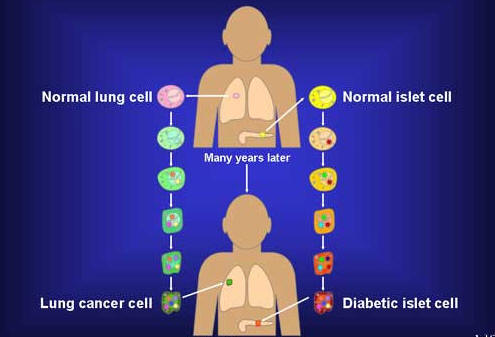
Psychiatric disorders are complex diseases, like cancer, diabetes, heart disease, and kidney disease. All complex diseases arise from combinations of changes that occur in the same cell over a period of time. In cancer, these changes accumulate over many years. Only when a critical number of changes occur in the same cell does it finally become cancerous. To complicate matters further, there are many different types of cancer, each displaying different combinations of changes. Even within a single type, such as lung cancer or colon cancer, clinicians can identify subtypes, each marked by a unique set of changes.
How can researchers hope to identify and study all the changes that occur in so many different cancers? How can they explain why some people respond to treatment and not others? How can they explain why some smokers get lung cancer, and others do not? How can these differences be explained?
3
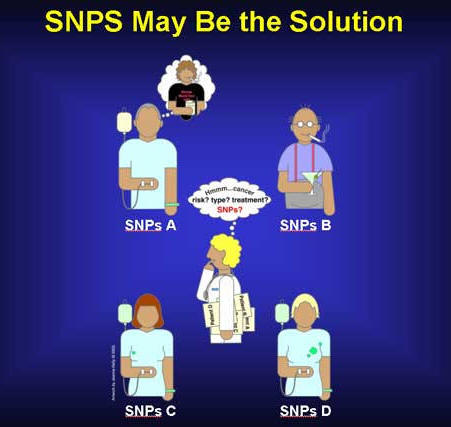
Scientists think that tiny variations in the human genome called Single-Nucleotide Polymorphisms, or SNPs (snips) for short, can help them to answer these questions. They believe SNPs can help them catalogue the unique sets of changes involved in different cancers. They see SNPs as a potential tool to improve cancer diagnosis and treatment planning. They suspect that SNPs may play a role in the different responses to treatments seen among cancer patients. And they think that SNPs may also be involved in the different levels of individual cancer risk observed.
So what exactly are SNPs? How are they involved in so many different aspects of health?To answer these questions, one first needs to look at the human genome.
4
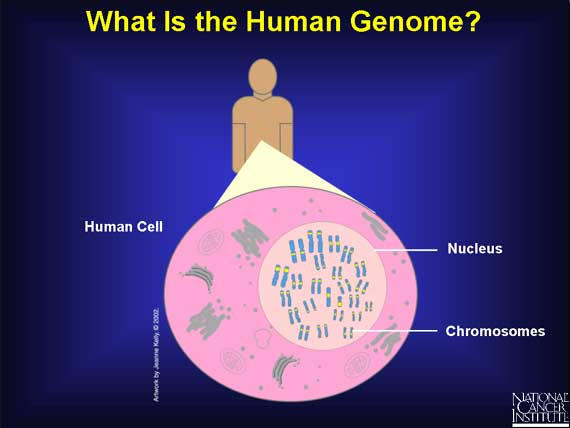
The human genome is the complete set of instructions for life as we know it. Except for red blood cells, which have no nucleus, the human genome is located in the nucleus of every cell in the body. There it is organized into 22 pairs of very large molecules called chromosomes and one pair of sex chromosomes.
5

Chromosomes are made of deoxyribonucleic acid (DNA). DNA contains only four chemical bases or building blocks: Adenine, Thymine, Cytosine, and Guanine - called A, T, G, and C, for short. There are roughly 3.2 billion chemical bases (A, T, C, G) in the human genome. Each DNA molecule is made up of two long complementary (related) strands, which are intertwined like a rope. This is the famous "double helix." Since A always pairs with T, and C with G, the order on one strand dictates the order on the other. This is called base pairing and enables the genome to make copies of itself.
6
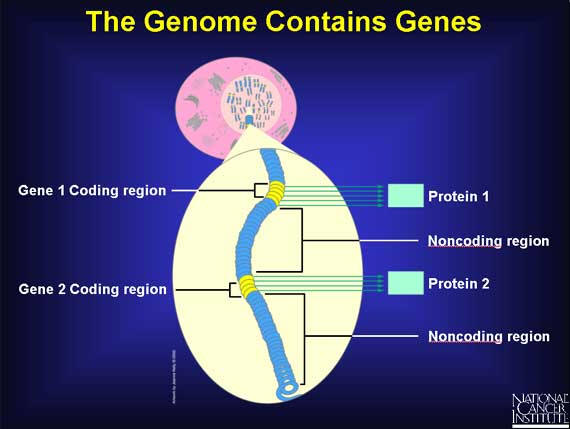
Only about 3 percent of the human genome is actually used as the set of instructions. These regions are called coding regions, and they are scattered throughout the chromosomes. A coding region contains genes. A protein-coding gene is a unique DNA sequence within a chromosome that ultimately directs the building of a specific protein with a specific function. Close to each gene is a "regulatory" sequence of DNA, which is able to turn the gene "on" or "off." Most functions of the remaining 97 percent of the genome are not yet known. These regions are called noncoding regions.
7
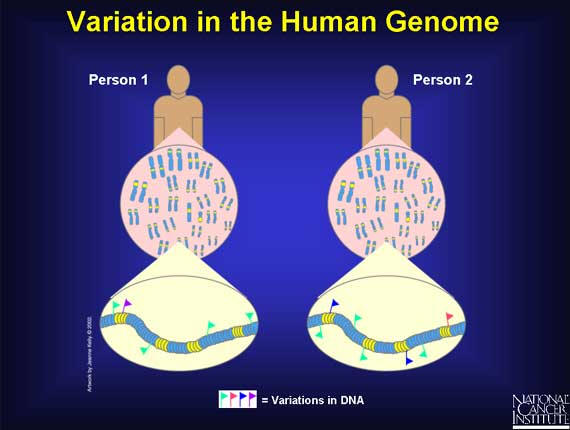
An amazing aspect of the human genome is that there is so little variation in the DNA sequence when the genome of one person is compared to that of another. Of the 3.2 billion bases, roughly 99.9 percent are the same between any two people. It is the variation in the remaining tiny fraction of the genome, 0.1 percent--roughly several million bases--that makes a person unique. This small amount of variation determines attributes such as how a person looks, or the diseases he or she develops.
8

Variation occurs whenever the order of the bases in a DNA sequence changes. Variations can involve only one base or many bases. If the two strands of a chromosome are thought of as nucleotides threaded on a string, then, for example, a string can break and the order of the beads can vary. One or more nucleotides may be changed, added, or removed. In chromosomes, these changes are called polymorphisms, insertions, and deletions. In addition to these changes, some DNA sequences called "repeats" like to insert extra copies of themselves several times. Chromosomes can also undergo more dramatic changes called translocations. These occur when an entire section of DNA on one chromosome switches places with a section on another. Not all variations in the genome's DNA sequences have an effect. Among the variations that do cause effects, some are more serious than others. The outcome depends on two factors: where in the genome the change occurs, (i.e., in a noncoding region, coding, or regulatory region) and the exact nature of the change.
9
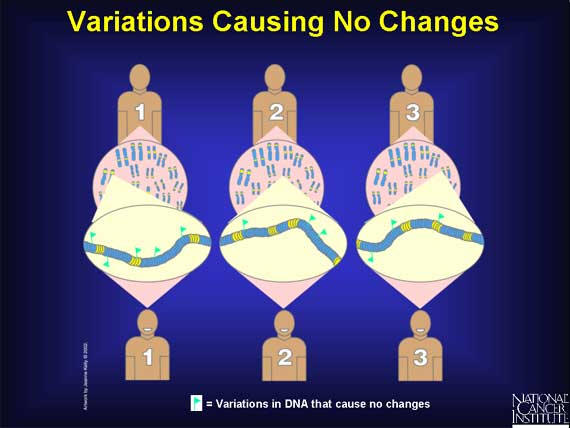
Most variations in the human genome have no known effect at all because they occur in noncoding regions of the DNA. In addition, there are some changes that do occur in coding and regulatory regions, yet they have no known effect. All these are silent variations.
10

Some of the variations that occur in the coding and regulatory regions of genes have "harmless" effects. They can, for example, change the way a person "looks." Some people have blue eyes, others brown; some are tall, others short; and some faces are oval, others round. Other variations in coding regions are harmless because they occur in regions of a gene that do not affect the function of the protein made.
11
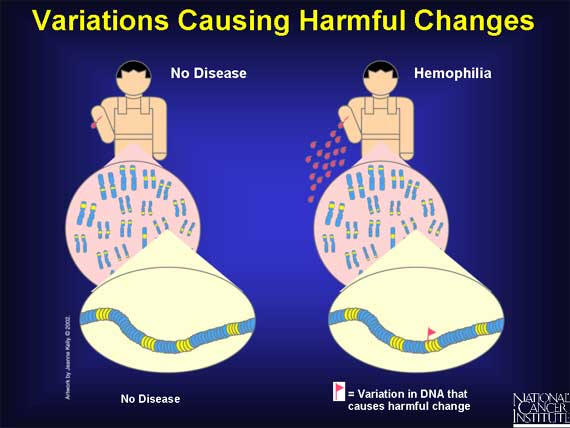
There are a group of variations in coding and regulatory regions that result in harmful effects. These are called mutations. They cause disease because changes in the genome's instructions alter the functions of important proteins that are needed for health. For example, diabetes, cancer, heart disease, Huntington's disease, and hemophilia all result from variations that cause harmful effects. In a "simple" disease such as hemophilia, variation in one gene is sufficient to cause disease symptoms. By contrast, in a "complex" disease like cancer, symptoms are seen only after many variations have occurred in different genes in the same cell.
12
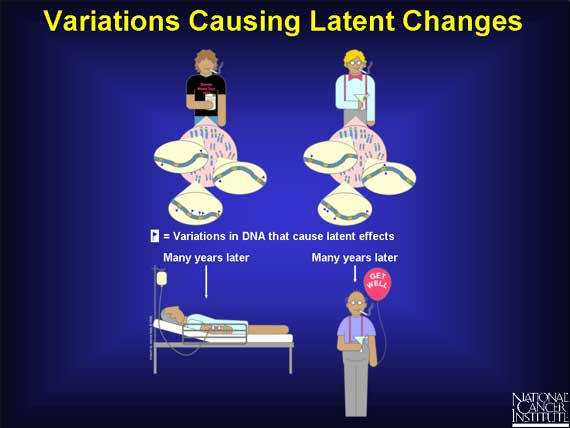
Finally, there are genetic variations that have "latent" effects. These variations, found in coding and regulatory regions, are not harmful on their own, and the change in each gene only becomes apparent under certain conditions. Such changes may eventually cause some people to be at higher risk for cancer, but only after exposure to certain environmental agents. They may also explain why one person responds to a drug treatment while another does not. Here is part of the genome from two people who are both smokers and drinkers, but only one of them gets cancer. The zoom into the chromosomes of these two men shows just a sampling of the differences in variation that are responsible for their individual cancer risk. The variations themselves do not cause cancer. They only affect each person's susceptibility to tobacco smoke and alcohol after exposure.